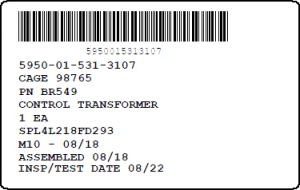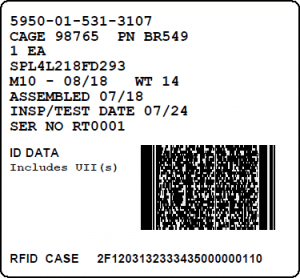The most common military labels used by defense contractors are the container labels that are specified by Mil-Std-129R. Container label formats vary depending on the packaging level of the container, as defined by the military standard:
- Unit Container/Pack – The first tie, wrap, or container applied to a single item, or a quantity thereof, or to a group of items of a single stock number, preserved or unpreserved, which constitutes a complete or identifiable package.
- Intermediate Container – A wrap, box, or bundle containing two or more unit packs of identical items. Normally one or more intermediate packages will be bundled to make a shipping container.
- Exterior Container – A container, bundle, or assembly that is sufficient by reason of material, design, and construction to protect unit packs and intermediate containers and their contents during shipment and storage. It can be a unit pack or a container with a combination of unit packs or intermediate containers. An exterior container may or may not be used as a shipping container.
Mil-Std-129R
The military labeling standard includes some examples of label formats, but does not attempt to define acceptable label formats. Instead, it strictly defines the information needs to be on labels for each container level. So it is important to understand these packing/container levels.
The Standard allows for reasonable variation in label formatting in order to accommodate the size of the package and the technical requirements of the container identification. More information on this is available in the Guide To Mil-Std-129R Labeling.
For some of the more technical elements, such as the linear bar codes, physical characteristics are defined. For two-dimensional symbols, the contents of their data structures are also defined. This permits the defense contractor to produce labels that military activities are able to read and understand.
Military Shipment Label (MSL)
Another label defined by Mil-Std-129R is the Military Shipment Label (MSL). The primary purpose of the label is to provide shipping instructions for shipments once they reach a defense depot or enter the defense transportation system. Fields like TCN, Priority, Project and FMS Case assist in the proper handling of shipments. More information on understanding the Military Shipment Label (MSL).
The modern Military Shipment Label was derived from Form DD1387, with few differences except for the two-dimensional PDF417 symbol. This machine-readable data structure includes all of the data on the face of the label, as well as some limited information about the container contents.
Permanent Identification Marking, including IUID
Permanent identification marking, also referred to as part marking, falls under Mil-Std-130. This includes the requirements for Item Unique Identification (IUID). Part marking requires identification that is permanently affixed to an item, without effecting its performance. It must remain affixed and readable for the expected life of the item. For IUID-marked items, the machine-readable interface must maintain readability for the lifespan of the item as well.
While in some cases permanent part marking may be successfully accomplished with labels generated by laser or thermal transfer printers, more rigorous methods are required for parts that must withstand the environmental conditions of storage and use in the field. It requires special methods and materials, and rigorous testing to ensure that marks are compliant and survivable.
IUID Labeling for Shipping
Once parts have been marked, there is still much work to done with UID data. Each IUID must appear on up to three different IUID container labels to meet the requirements of Mil-Std-129R. For containers with more than five items, their IUIDs are listed on a barcode Serial Number List. Then this data must be reported on a WAWF DD250 Receiving Report.
For RFID shipments, each IUID has to be reported to WAWF again, correlated to the container RF-tags. Fortunately, WAWF automation solutions like MIL-Comply automatically collect and organize this data whenever special RFID-enabled IUID labels are used. It can be included in an EDI DD250 or submitted separately as an RFID Pack Update transaction.
In summary, when considering military labeling solutions,importance considerations may include:
- Robustness of Mil-Std-129 label formats supported
- Support for Mil-Std-130 IUID part marks, if appropriate
- Automated handling of IUID container data
- Automated RFID labeling and collection of CLIN and IUID data
- Compatibility with WAWF process




